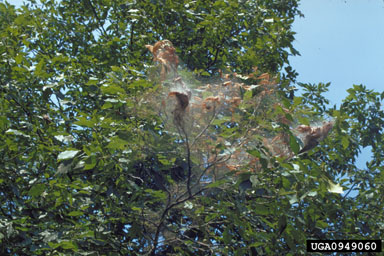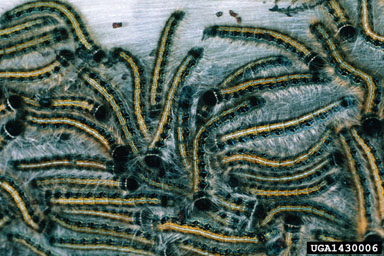Eastern Tent Caterpillars
go.ncsu.edu/readext?520868
en Español / em Português
El inglés es el idioma de control de esta página. En la medida en que haya algún conflicto entre la traducción al inglés y la traducción, el inglés prevalece.
Al hacer clic en el enlace de traducción se activa un servicio de traducción gratuito para convertir la página al español. Al igual que con cualquier traducción por Internet, la conversión no es sensible al contexto y puede que no traduzca el texto en su significado original. NC State Extension no garantiza la exactitud del texto traducido. Por favor, tenga en cuenta que algunas aplicaciones y/o servicios pueden no funcionar como se espera cuando se traducen.
Português
Inglês é o idioma de controle desta página. Na medida que haja algum conflito entre o texto original em Inglês e a tradução, o Inglês prevalece.
Ao clicar no link de tradução, um serviço gratuito de tradução será ativado para converter a página para o Português. Como em qualquer tradução pela internet, a conversão não é sensivel ao contexto e pode não ocorrer a tradução para o significado orginal. O serviço de Extensão da Carolina do Norte (NC State Extension) não garante a exatidão do texto traduzido. Por favor, observe que algumas funções ou serviços podem não funcionar como esperado após a tradução.
English
English is the controlling language of this page. To the extent there is any conflict between the English text and the translation, English controls.
Clicking on the translation link activates a free translation service to convert the page to Spanish. As with any Internet translation, the conversion is not context-sensitive and may not translate the text to its original meaning. NC State Extension does not guarantee the accuracy of the translated text. Please note that some applications and/or services may not function as expected when translated.
Collapse ▲
Fall Webworm
Linda Haugen, USDA Forest Service, Bugwood.org
Nests or ‘tents’ of the eastern tent caterpillar, Malacosoma americanum, are a common problem in the spring in Macon County, especially in our wild cherry trees.
The eastern tent caterpillar makes its nest in the fork of branches. It does not enclose leaves like the webs of a similar caterpillar, the fall webworm, do. Tent caterpillars are generally active until early June and fall webworms are active in July through September.
The eastern tent caterpillars prefer wild cherry, but it can be found in apple, crabapple, plum, peach, and cherry in landscapes. Occasionally it will form nests in ash, birch, willow, maple, oak and poplar. The favorite food of the forest tent caterpillar is wild cherry but oaks, maples, hawthorns, and many other shade and forest trees may be attacked.
Trees can be partially or completely defoliated. Since this defoliation occurs early in the season, the plants must set out new leaves at considerable energy expense. Besides making a tree look unsightly with its webs, these caterpillars cause concern when seen by the thousands traveling over roads, streets, driveways, and sidewalks during periods of migration.
The eastern tent caterpillar is easily identified when it builds its white silk nest in the crotch of small trees or where several limbs meet on larger trees. They are hairy and black in color with irregular blue and white mottling. Some of the white markings appear as stripes on their back. Tent caterpillars overwinter in the egg stage. The eggs hatch in early spring just as the leaf buds begin to show green.
The tiny black caterpillars sun themselves on the egg mass but soon move to a nearby fork in the branches. Here they begin to spin silk and form a tent.

Eastern Tent Caterpillar
Lacy L. Hyche, Auburn University, Bugwood.org
The larvae migrate to the new leaves to feed, usually in the morning or early afternoon. After feeding the larvae return to the nest. Feeding continues for four to six weeks until the larvae are about two inches long. Mature larvae usually leave the nest and tree to search for a suitable place to spin a cocoon. The larvae spin compact, spindle‑shaped cocoons of white to yellow silk. The adults emerge in two to four weeks. Mating occurs soon after emergence and the females attach their new egg masses to tree branches. These masses stay on the tree until the following spring. There is only one generation per year.
People often get overly concerned when they see large numbers of nests in roadside wild cherry. Fortunately, these pests rarely reach large populations in ornamental trees. There are several preventative and control measures you can take. In the spring, scrape the nest off onto the ground and crush
the caterpillars or drop them into a pan of soapy water. It is suggested that a glove be used as the caterpillar hairs are irritating to some people. Early morning or late afternoon is best because most of the caterpillars will be in the tent.
Most commercial Bt products for caterpillar control will work on the tent caterpillars. Make applications to the plant foliage while the larvae are small. Numerous predators and parasites also attack this pest but may not adequately control tent caterpillars.
Many insecticides rapidly control this pest. Direct sprays to the plant foliage and nest. The larvae are usually easy to contact if spraying is done in late morning when the larvae congregate on the tent surface to warm in the sun. Be sure that the insecticide is labeled for this use. Always follow the label instructions.

Eastern Tent Caterpillar Nest
Robert L. Anderson, USDA Forest Service, Bugwood.org




